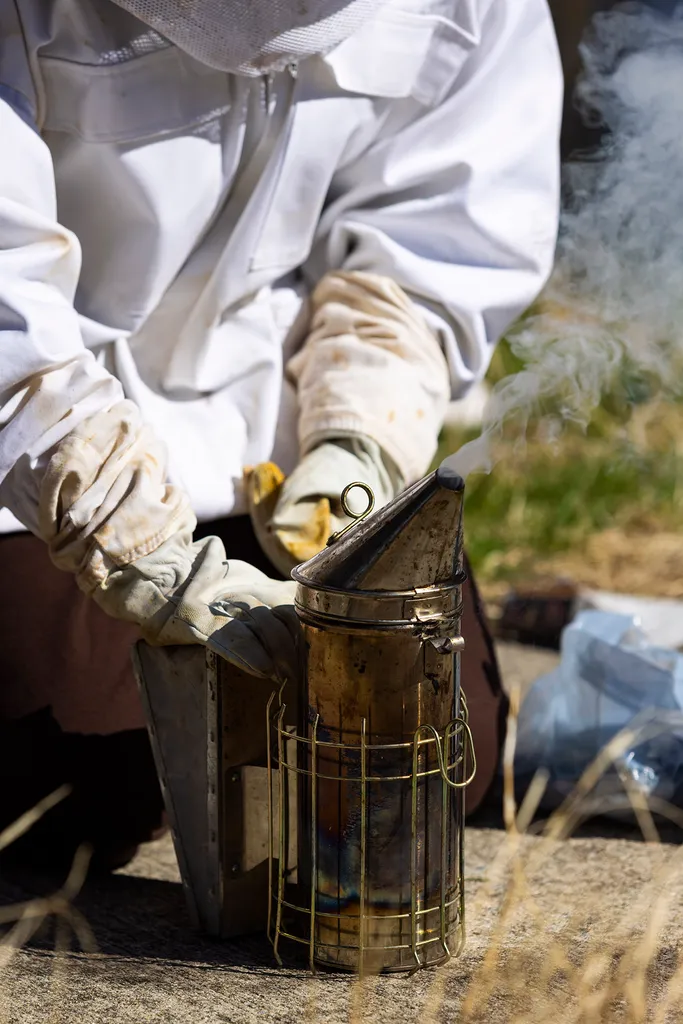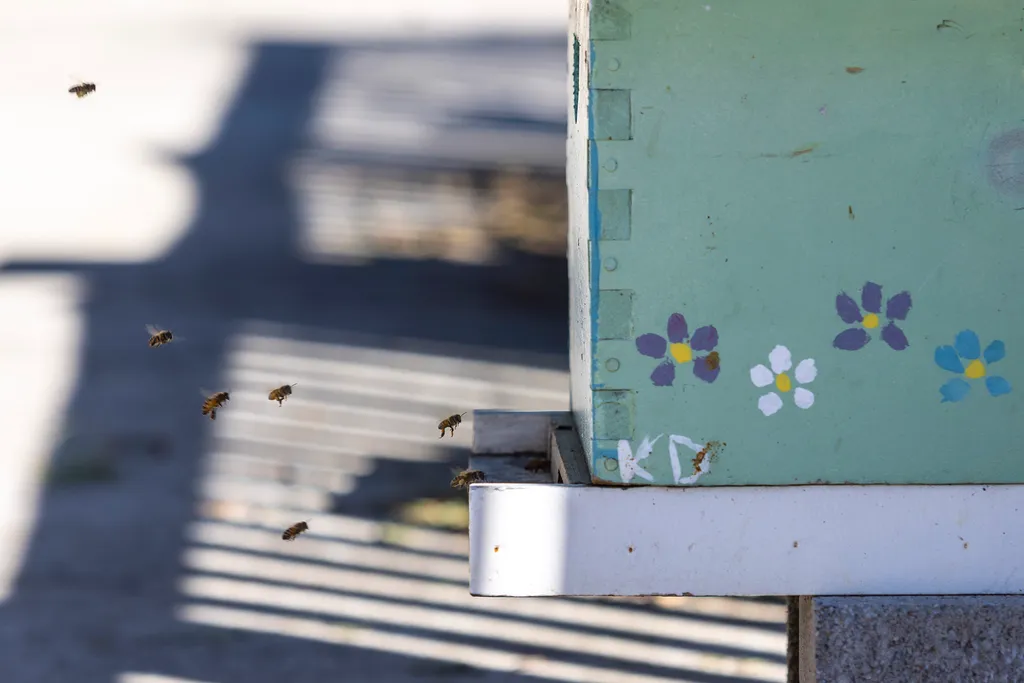- April 10, 2025
- By Karen Shih ’09
Smoke wafting from a can in her heavily gloved hand, Lila Wilson ’26 bent down in her bee suit to examine one of three student-managed hives up the hill from the Xfinity Center.

“Oo, there’s some uncapped honey,” said the University of Maryland Beekeeping Club president as she gently pulled out one of seven frames inside the box, each of which can hold about 2,000 bees. “See that shiny stuff inside?”
With spring flowers blooming (and pollen counts sky-high), it’s time for bee populations to boom. In late March, Wilson, accompanied by club members Milo Rickert ’28 and Samidha Nageshwar ’28, was on the lookout for “swarm cups,” extra cells built outside of the usual cells in the frame that indicate the colony is getting too big and ready to split in two. To prevent the residents from flying off, the club proactively moves a new queen into an empty hive in hopes that worker bees will follow.
Unlike pets, “if bees don’t like what you’re doing, they can and will leave,” said Wilson. “So that’s the incentive we have to treat them well and provide them with a good home.”
Are you un-bee-lievably intrigued? Here’s what you need to know about the club:
How It Got Started: Founded more than a decade ago, the club has gone through some tumultuous times with the cyclical rise and fall of its honeybees. A particularly cold winter can kill off colonies. A strong summer storm can send trees or branches crashing down and damage hives. Pests like varroa mites or hive beetles can weaken populations. But through it all, students have persisted in caring for the bees, first in the woods behind Xfinity Center, and now in a more accessible location outside the Research Greenhouse.

When It Meets: Every Thursday, members learn during workshops at the greenhouse building, where they might make candles out of beeswax or learn how to care for hives. A recent presentation on the history of beekeeping even explored a litany of historic inaccuracies about bees, such as beliefs that they came from cows.
In warmer months, Saturday morning hive checks ensure the population is going strong. Wilson opens the lid for each box, then carefully removes their frames to look for eggs and larvae, honey production and signs of disease, as well as confirm the queen is identifiable and healthy.
Who Can Join: Anyone who’s curious, doesn’t mind suiting up from head to toe in protective gear and is willing to sign a waiver (stings do occasionally happen). Wilson started with no experience—her first role with the club was mowing the grass to clear a path around the hives in its old wooded location—and learned everything she knows from club adviser Eric Malcolm, the apicultural extension educator and apiary manager of the UMD Bee Lab, as well as previous club leaders. Rickert, who grew up with hives in their backyard in Poolesville, Md., is an outlier, but their knowledge is a welcome addition. The group has about two dozen members.

Fun Traditions: Naming and painting the hives: “We have a whole server on our Discord that’s just for bee puns,” Wilson said. Monikers have included “Buzzy Holly by Beezer,” “Hatsune Bee-ku” (for the Japanese virtual idol) and of course, “Bee Gees.” The colorful designs on the hives were part of a winter project, when club members have less to do because they don’t open the hives in the cold.
Honey extraction: If their colonies are thriving, beekeepers can harvest honey late in the summer. Last year was the first time Wilson was able to do that with the club’s hives, and she and fellow club members spent an entire Saturday “uncapping” the frames (scraping off the wax layer to expose the liquid inside), putting them into a specialized centrifuge to extract the honey, then straining it. They ended up with half a bucket’s worth, distributed among members.
This is part of an occasional series highlighting interesting UMD student clubs. Have a suggestion for one to feature? Email kshih@umd.edu.
Fun facts about bees:
- Honey is bee vomit: Multiple bees will consume the same nectar and throw it back up in succession. The chemicals in their special honey stomachs make it more and more dense, eventually creating the viscous amber goop we’re familiar with. “People get kind of disgusted when they find out,” said Rickert.
- Queens are ruthless: When a colony gets too big, the old queen will lay several new potential queens into cells in the hive to ensure at least one survives. But when the first one emerges, she makes a sound called “piping” that gets a response called “quacking” from the others that are still stuck inside. She kills all the ones she hears, ensuring her dominance.
- They fly shockingly far: A tiny honeybee can travel up to five miles from home to collect nectar and pollen. “They’ll work themselves to death a lot of the time,” said Wilson. “They don’t have that work-life balance.” Worker bees only live 30-50 days, while a queen can survive for up to five years.
